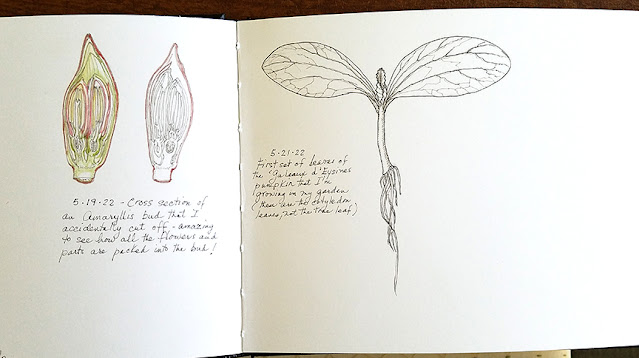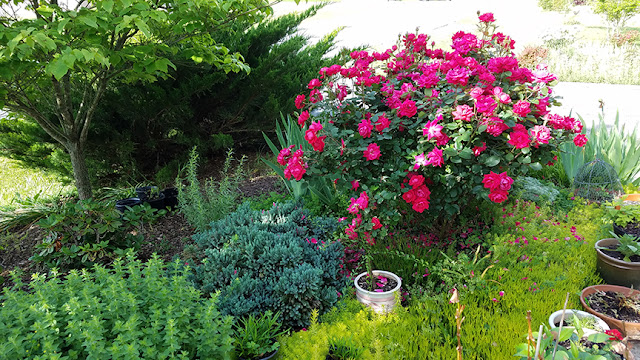 |
| Field sketch of the Mountain Camellia (Stewartia ovata), watercolor, 8" x 10" |
For the past few years I've been searching for a good specimen of our native Mountain Camellia (Stewartia ovata) to paint. The Virginia State Arboretum, AKA Blandy Farm, has three Stewartias, but all three are Asian in origin: S. koreana (which I sketched a couple of weeks ago), S. serrata, and S. monadelpha, which is Japanese. I've visited these trees for several years and noted that they tend to bloom in late spring, early to the middle of June. All of these have beautiful single flowers, but I wanted to find an American species, at least one of the two species of the Camellia family that are native to North America.
I tried to grow one from seed purchased at Sheffields, but despite following the stratification instructions precisely, I never got a single one to sprout. Apparently this species of Stewartia is rare because it requires very specific conditions to grow and survive.
I found a blog that mentioned a field trip in the mountains of North Carolina where they had encountered several stands of this Stewartia and Emailed the blogger to get more information, but got no response. I then tried my contacts in the Virginia Native Plant Society with much better results. Botanist Gary Fleming put in in touch with Dr. Donna M. E. Ware in Williamsburg, who told me that she knew of a specimen of Stewartia ovata in the Colonial Williamsburg Arboretum.
She was kind enough to put me in touch with a gentleman who is a volunteer there, and Ricklin Brown agreed he would monitor the plant and let me know when it came into bloom, which would likely be in early to the middle of June.
 |
| Map of the Basset Trace Nature Trail (from brochure) |
I had been checking out hotels in the Williamsburg area where I could spend the night, so when I received Ricklin's Email on the second weekend in June, I decided to drive down on Monday morning, and made my reservation.
Ricklin had agreed to meet me in the parking lot of the Griffin Hotel, where the Basset Trace Nature Trail begins, and guide me to the Stewartia, so I wouldn't miss it. I arrived at the parking lot a bit after one o'clock, after a wrong turn or two around William and Mary College. I didn't see anyone that could be Ricklin, so I waited there for a while and ate my sandwich. Then my cell phone rang--it was Rick--turns out the hotel had two parking lots and I was in the wrong one!
I found Rick on the way to the other parking area, got my gear ready, and we started out on the Basset Trace Nature Trail. Rick was an excellent guide and docent, entertaining me with stories of the history of this area: the Rockefellers and the home they once owned here, he showed me the grand vista of trees they had hired a landscape architect to create in the 1920's.
The trail was well-marked with blazes and shady, thank heaven--it was very warm and humid--but it ran up and down the hills, with bridges across creeks and one detour around a part of the trail that had washed out and needed repairs. As I walked on, the weight of my painting equipment in my tote bag became heavier and slowed me down so much that Rick offered to take the portable chair I was carrying in my other arm, and so we marched on towards our goal. At the sign marking the 3/4 mile point there was a bench by the trail, with the Stewartia ovata just ten paces away.
 |
| The Stewartia ovata tree. |
It was a small tree, in size and appearance much like a dogwood--the lovely white flowers and pearl-like buds were barely visible until you got up close. I studied the tree to determine where to sit to get the best view of at least one flower and some buds, and saw that the most likely branch was just a bit too high for me to get a good view. I pulled the branch somewhat, trying to coax it downward, when Rick had the brilliant idea to take a fallen branch from some other tree that was nearby, and used it to weigh down the blooming branch just enough to allow me a good view from a sitting position on my portable chair. He placed the branch carefully so that it wouldn't damage the Stewartia, and when removed, the living branch could spring back into its normal position.
 |
| Flowering branch of Stewartia ovata. |
Thus arranged, Rick left me and I started to work on my sketch, drawing the flowers and leaves lightly in pencil. I realized then that I'd forgotten to spray myself with insect repellent before starting out. Too late now to hike back to my car to retrieve the can of spray; oh well, I'd have to endure whatever might attack me.
Once I had everything positioned, I whipped out my watercolor pencils to begin shading the flowers. I was able to observe that the stamens in center of the flower were delicately shaded in lavender at the base of the filaments, and became slightly darker as they aged. After I'd captured the shading of the forms, a touch of my waterbrush blended the colors.
 |
| Close-up of the flower and bud. |
I decided to use my regular plein aire watercolors for the leaves--the range of greens of the watercolor pencil set I have is not the best for capturing the many subtle variations of green found in nature. It took much longer to do the leaves than the flowers and buds. I still don't think I got the exact shade of green in my sketch, but it was the best I could do with the palette I had.
 |
| Stewartia ovata fertilized flower and bud |
When the leaves were done, I felt the heat of the sun at my back and realized that the sun had descended quite a bit--I looked down at my watch and saw that it was about five o'clock--three hours had passed in the blink of an eye! I got up from my chair and I was so stiff I could hardly move. I walked around a bit to shake out the stiffness and took some more photos of the tree and the flowers before packing up and starting the hike back.
I got back to my car around six, tired and drenched in sweat, ready to check into my hotel and a hot shower. When I got to the Sleep Inn, the lady at the counter pointed out that my reservation was for the next night (oh no, I'd put in the wrong date on the on-line form!), but that was easily fixed. I got my stuff in the room and stripped--every piece of clothing I was wearing was soaked!
After a delicious dinner at local restaurant Food for Thought, I went back to my hotel, totally exhausted. Sleep eluded me, though--I was covered in insect bites and all the Benadryl in the world barely made a dent--I itched all through the night.
I'd intended to hike back the following morning to meet Donna, but overslept and almost missed the breakfast at the hotel. That was a stroke of luck, because as I was in my car about to drive out, I got a call from Donna. It was pouring at her house a few miles up the road, and sure enough, even as we were speaking on the phone, the rain started--buckets and buckets. I would have been soaked had I been out on the trail. We agreed to meet at my hotel and have some coffee nearby to get a chance to talk while the deluge went on.
Donna is a charming lady and so knowledgeable! She is a botanist who was the Curator of the Herbarium at William and Mary College for over thirty years; she still volunteers at the Williamsburg Botanical Garden. She had some fascinating information about Stewartia ovata and its spotty distribution here in Virginia's coastal plain--known as a disjunct in botanical terms. This refers to plant species that are found in widely separated geographic areas, so that breeding populations could not possibly exchange genetic material.
The theory is that S. ovata grew in the Southern Appalachian Mountains, and survived by migrating eastward toward the coastal plain during the last Ice Age. After the ice retreated and the climate became warmer once again, this Stewartia managed to persist only in very specific environments of the coastal plain: forests with deep ravines and shady creeks where moisture and slightly alkaline soils exist. The plant is still found in the mountains of the Carolinas, but Virginia's Appalachian region is apparently a bit too cold for it nowadays, so it doesn't grow here.
I headed back home after my meeting with Donna, happy to have finally had the opportunity to see and sketch this rare and beautiful native tree. I plan to do a more finished painting of it later on, perhaps rendered on parchment vellum--a flower this lovely deserves to be immortalized in the best possible way!












































